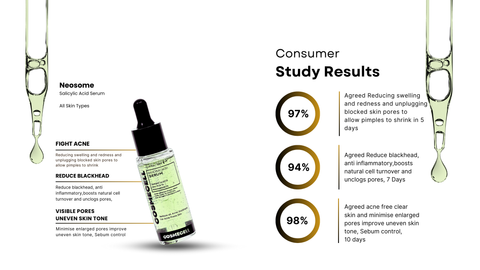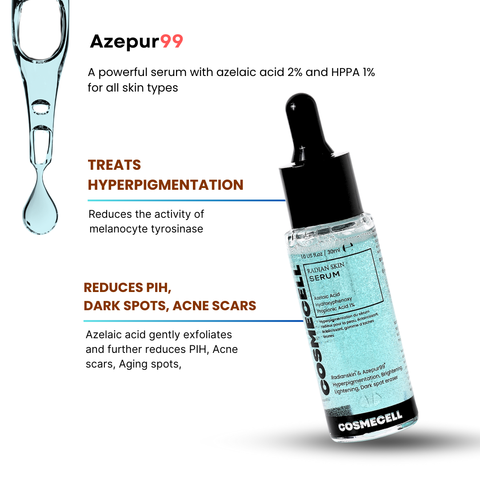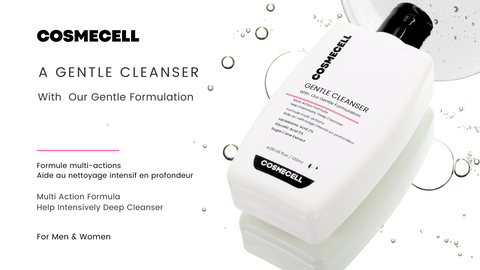Understanding Acne-Prone Skin
Acne-prone skin requires special attention and carefully selected ingredients to maintain clarity and health. This skin type is characterized by frequent breakouts due to excess sebum production, clogged pores, and bacterial proliferation. The sebaceous glands in acne-prone skin often produce more oil than necessary, creating an environment where acne-causing bacteria can thrive.
The complexity of acne extends beyond mere surface-level concerns. It involves a delicate interplay of hormonal fluctuations, genetic predispositions, and environmental triggers. Understanding these underlying mechanisms is crucial for effectively managing acne-prone skin and selecting appropriate ingredients that address the root causes rather than just alleviating symptoms.
Common Triggers for Acne Breakouts
Identifying your specific acne triggers is an essential step in crafting an effective skincare regimen. Hormonal changes often precipitate breakouts, particularly during adolescence, menstruation, pregnancy, or periods of significant stress. Dietary factors may exacerbate acne in some individuals, with high-glycemic foods and dairy products being frequent culprits.
Environmental pollutants can accumulate on the skin's surface, potentially obstructing pores and catalyzing inflammatory responses. Additionally, certain cosmetic products containing comedogenic ingredients may aggravate acne-prone skin by impeding the natural exfoliation process. Understanding these multifaceted triggers allows for more targeted and efficacious skincare approaches.
"The key to managing acne-prone skin isn't just treating existing breakouts but preventing new ones through consistent care and appropriate ingredient selection." – American Academy of Dermatology
Essential Ingredients for Acne Treatment
When combating acne, certain ingredients have demonstrated remarkable efficacy through scientific research and clinical applications. These powerhouse components work through various mechanisms—some regulate oil production, others combat bacteria, while some accelerate cell turnover to prevent clogged pores. Incorporating these ingredients into your skincare regimen can significantly ameliorate acne concerns and promote clearer skin.
Salicylic Acid: The Pore Cleanser
Salicylic acid, a beta-hydroxy acid (BHA), stands as one of the most efficacious ingredients for acne-prone complexions. This lipophilic compound penetrates oil-filled pores to exfoliate from within, dislodging accumulated sebum and cellular debris. At concentrations between 0.5% and 2%, salicylic acid effectively mitigates comedones without excessive irritation.
Beyond its exfoliating capabilities, salicylic acid exhibits anti-inflammatory properties that can assuage redness and swelling associated with inflamed acne lesions. Its keratolytic action helps normalize the excessive keratinization process often observed in acne-prone skin, preventing the formation of new blemishes while addressing existing concerns.
Benzoyl Peroxide: The Bacteria Fighter
Benzoyl peroxide functions as a potent antimicrobial agent that specifically targets Propionibacterium acnes, the bacteria implicated in acne development. This ingredient operates by introducing oxygen into the pore environment, creating hostile conditions for anaerobic bacteria. Available in concentrations ranging from 2.5% to 10%, benzoyl peroxide demonstrates a dose-dependent efficacy profile.
A noteworthy attribute of benzoyl peroxide is its ability to circumvent bacterial resistance, a mounting concern with antibiotic treatments. It also possesses mild comedolytic properties, facilitating the dissolution of keratin plugs that obstruct follicular openings. When incorporating benzoyl peroxide into your regimen, be cognizant of its potential bleaching effect on fabrics and its occasionally desiccating impact on skin.
Natural Ingredients That Combat Acne
For those seeking naturally derived alternatives, numerous botanical ingredients offer compelling benefits for acne-prone skin. These natural components often provide antimicrobial, anti-inflammatory, and sebum-regulating properties without the potential harshness of some synthetic compounds. Integrating these botanical ingredients can offer a gentler approach, particularly for those with sensitive yet acne-prone complexions.
Tea Tree Oil: Nature's Antiseptic
Derived from the Melaleuca alternifolia plant, tea tree oil has garnered significant attention for its antimicrobial properties. Studies indicate that a 5% tea tree oil solution can rival the efficacy of 5% benzoyl peroxide in reducing acne lesions, albeit with a slower onset of action. The terpinen-4-ol compound within tea tree oil confers both antibacterial and anti-inflammatory benefits.
When utilizing tea tree oil, dilution is imperative to prevent cutaneous irritation. A concentration of 3-5% in a carrier oil or incorporated into formulations represents an optimal balance between efficacy and tolerability. Regular application can progressively diminish bacterial proliferation while concurrently reducing the inflammatory cascade associated with acne lesions.
Niacinamide: The Versatile Vitamin
Niacinamide, or vitamin B3, exemplifies versatility in acne management. This water-soluble vitamin regulates sebum production, strengthens the skin barrier, and possesses anti-inflammatory properties. Research demonstrates that a 4% niacinamide formulation can significantly reduce sebum levels and improve overall skin texture after eight weeks of consistent application.
The multifunctional nature of niacinamide extends to addressing post-inflammatory hyperpigmentation, a common sequela of acne lesions. Its ability to inhibit melanosome transfer to keratinocytes helps prevent discoloration, rendering it particularly valuable for individuals with darker skin tones or those prone to post-acne marks.
Advanced Ingredients for Persistent Acne
For recalcitrant acne that proves resistant to conventional treatments, several advanced ingredients offer heightened potency and specialized mechanisms of action. These sophisticated components often require professional oversight or prescription access due to their potent effects and potential for adverse reactions if improperly utilized.
| Ingredient | Mechanism of Action | Best For |
|---|---|---|
| Retinoids | Accelerates cell turnover, prevents follicular plugging | Comedonal acne, maintenance therapy |
| Azelaic Acid | Antimicrobial, anti-inflammatory, reduces hyperpigmentation | Inflammatory acne with post-acne marks |
| Alpha Hydroxy Acids | Surface exfoliation, improves skin texture | Mild to moderate acne, congested skin |
Retinoids: The Gold Standard
Retinoids, derivatives of vitamin A, remain the dermatological gold standard for comprehensive acne management. These compounds normalize follicular keratinization, inhibit microcomedone formation, and modulate inflammatory responses. Tretinoin, adapalene, and tazarotene represent prescription-strength options, while retinol offers an over-the-counter alternative with milder effects.
Implementing retinoids necessitates a measured approach—initiating with lower concentrations and gradually increasing frequency as tolerance develops. These compounds can precipitate a temporary acne exacerbation, colloquially termed "purging," as they accelerate the emergence of subclinical lesions. Consistent application typically yields visible improvements within 8-12 weeks, with continued enhancement over extended use.
Ingredients to Avoid for Acne-Prone Skin
While identifying beneficial ingredients is crucial, equally important is recognizing components that may exacerbate acne concerns. Certain ingredients can occlude pores, stimulate excess sebum production, or trigger inflammatory reactions that aggravate existing acne. Vigilantly scrutinizing product formulations to exclude these problematic ingredients can significantly enhance treatment outcomes.
Comedogenic Oils and Butters
Numerous cosmetic oils and butters possess comedogenic properties, meaning they can obstruct pores and foster acne development. Coconut oil, despite its popularity, exhibits high comedogenicity and should generally be eschewed by those with acne-prone skin. Similarly, cocoa butter, wheat germ oil, and soybean oil demonstrate pore-clogging tendencies that can undermine acne management efforts.
Instead, prioritize non-comedogenic alternatives such as grapeseed oil, sunflower oil, or squalane, which provide hydration without compromising pore clarity. The molecular structure of these oils enables them to nourish the skin without creating an occlusive barrier that traps sebum and cellular debris.
- High comedogenicity oils to avoid: coconut oil, palm oil, wheat germ oil
- Moderately comedogenic ingredients: cocoa butter, almond oil, avocado oil
- Non-comedogenic alternatives: grapeseed oil, jojoba oil, squalane
Creating Your Acne-Fighting Skincare Routine
Establishing an effective skincare regimen for acne-prone skin requires strategic sequencing of products and ingredients. The optimal routine balances active treatment with proper hydration and protection, addressing multiple facets of acne pathophysiology without compromising the skin barrier. Consistency proves paramount, as acne management represents a marathon rather than a sprint.
Morning vs. Evening Routines
Morning routines for acne-prone skin should emphasize protection and prevention. Begin with a gentle cleanser containing salicylic acid or benzoyl peroxide to remove overnight oil accumulation. Follow with an antioxidant serum containing niacinamide or vitamin C to combat oxidative stress and strengthen the skin barrier. Conclude with a non-comedogenic, oil-free moisturizer and broad-spectrum sunscreen to prevent post-inflammatory hyperpigmentation.
Evening routines offer an opportunity for more intensive treatment. After thorough cleansing, apply treatment products containing retinoids, azelaic acid, or higher concentrations of salicylic acid. Allow these active ingredients adequate absorption time before applying a reparative moisturizer that supports overnight barrier recovery without occluding pores. This nocturnal window capitalizes on the skin's natural regenerative processes to maximize therapeutic benefits.
Frequently Asked Questions About Acne Ingredients
Can I use multiple active ingredients simultaneously?
Combining active ingredients requires careful consideration to avoid excessive irritation. While certain combinations can synergistically enhance results, others may prove counterproductive. Benzoyl peroxide and salicylic acid can generally be used concurrently, ideally in different products applied at separate times. However, retinoids and benzoyl peroxide may neutralize each other's effectiveness if applied simultaneously and potentially increase irritation.
A prudent approach involves introducing one active ingredient at a time, allowing the skin to acclimate before incorporating additional components. Alternating active ingredients—for example, applying benzoyl peroxide in the morning and retinoids at night—often maximizes benefits while minimizing potential adverse reactions.
How long should I use an ingredient before determining its effectiveness?
Acne ingredients typically require consistent application over specific timeframes to demonstrate appreciable results. Salicylic acid and benzoyl peroxide may yield improvements within 2-4 weeks, particularly for superficial acne lesions. Conversely, retinoids often necessitate 8-12 weeks of regular use before significant enhancement becomes apparent.
It's imperative to maintain reasonable expectations and commitment to your regimen. Premature abandonment of potentially effective ingredients represents a common pitfall in acne management. Document your progress with photographs at consistent intervals to objectively evaluate improvements that may be subtle when observed daily.



